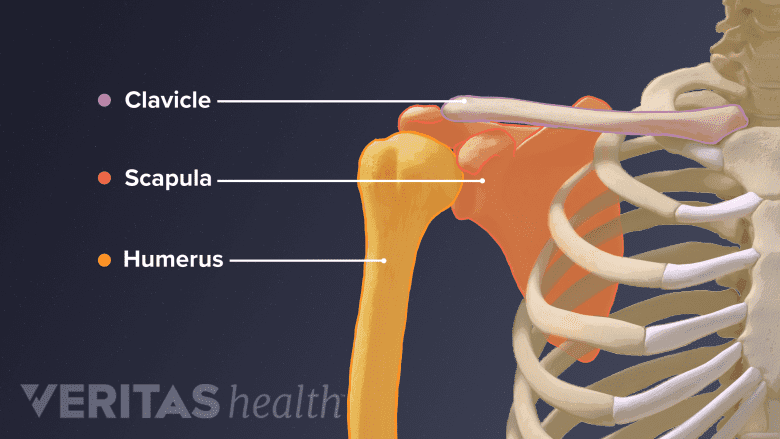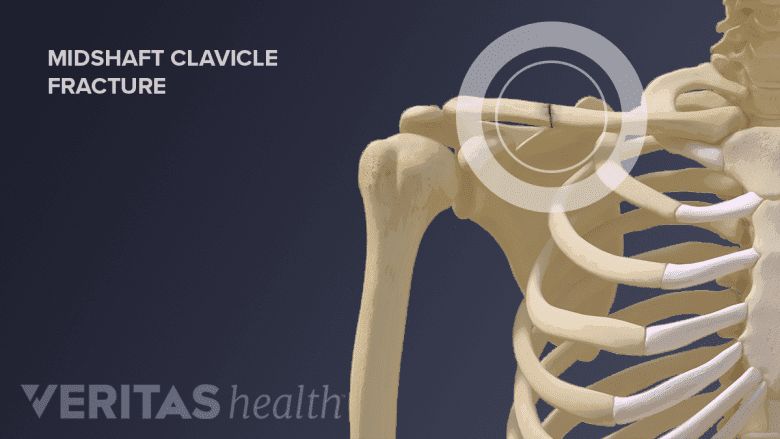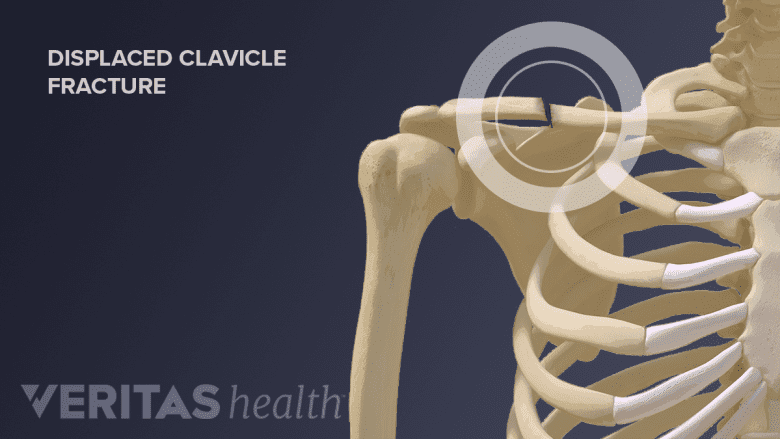A clavicle fracture is a complete or partial break in the collarbone – the horizontal bone that extends from the base of the neck out to the shoulder.

The clavicle, a slender bone at the neck base, provides rigid support between the shoulder blade and rib cage.
In This Article:
- Clavicle Fractures: Types and Symptoms
- Treating a Clavicle Fracture
The clavicle lies just beneath the skin, so a fracture usually causes an obvious protrusion or bump at the site of injury, along with significant pain and swelling. A small bony bulge is usually visible after the fracture heals.
What Is a Clavicle Fracture?
The essential points to know about a broken clavicle are:
- The fracture can occur anywhere along the length of the collarbone, and the most frequent site is the middle third of the clavicle.
- Clavicle fractures are one of the most common types of fractures in children.
- A cracking or snapping sound is usually heard when the fracture happens.
- Most fractures fuse and heal with non-surgical treatments, but there's a small chance of non-union of the bone, meaning the bone does not align and heal back properly on its own.
Collarbone fractures take 1 to 3 months to heal, and children typically recover faster than adults.
Types of Clavicle Fractures

The midshaft area is the most common area where a clavicle fracture occurs.
Medical professionals generally classify clavicle fractures into three groups:
- Group I or midshaft fractures: These occur in the middle third of the clavicle, where it is flatter and thinner than the rest of the bone. As mentioned above, this is the most common type of clavicle fracture.
- Group II or lateral fractures: These happen near the outer end of the collarbone, closest to the shoulder. These fractures make up between 21% and 28% of clavicle fractures.
- Group III or medial fractures: These occur near the inner end of the collarbone, at the base of the neck. They are the least common type and make up about <5% of all clavicle fractures.
Group I clavicle fractures are generally treated non-surgically and groups II and III may sometimes require surgery if the broken bone fragments need to be returned to their correct, anatomical position.
Read about The 3 Types of Shoulder Fractures
Stable, Displaced, and Comminuted Clavicle Fractures

A displaced fracture causes a visible deformity due to the misalignment of bones.
A fractured collarbone is further classified into 3 types based on the severity and position of the injured bone:
- Non-displaced or stable clavicle: The clavicle is broken but the two ends remain relatively aligned and haven't shifted out of place. A hairline fracture or crack in the clavicle is also categorized as a stable fracture.
- Displaced clavicle: The broken ends of the clavicle move out of their normal position. This misalignment causes a visible deformity.
- Comminuted clavicle: The clavicle breaks into multiple pieces. This type of fracture is often more severe and may be associated with injuries to nearby bones or tissues, such as the first rib or lungs. See Bone Break vs. Fracture
A collarbone fracture can sometimes be displaced and comminuted, meaning the bone is broken into multiple pieces and the pieces are out of alignment.
Symptoms and Signs
The fracture is typically associated with the following symptoms and signs:
- Severe pain localized to the collarbone area, which often worsens with shoulder or arm movement.
- Swelling and tenderness in the area around the fracture.
- Bruising or discoloration of the skin over the collarbone.
- Bone protrusion, which is noticeable as a visible bulge or lump at the fracture site.
- Limited movement in the arm and shoulder.
- Shoulder sagging occurs on the affected side, where the injured shoulder sags forward or downward.
- Numbness or tingling may occur in the arm or hand if the fracture affects nerves.
Occasionally, a person with a broken collarbone also experiences labored breathing, which is generally a sign of an injured lung.
Causes
Common causes of clavicle fractures are listed below:
- A fall on the shoulder is the most common cause of clavicle fractures and occurs due to:
- Loss of balance while walking, running, or climbing stairs
- Falling from a two-wheeled vehicle
- An athletic event, such as such as biking, horseback riding, and skateboarding
- Falling on an outstretched hand
- A direct hit to the collarbone or shoulder due to:
- A motor vehicle collision
- When playing contact sports, such as football, rugby, and hockey
Risk Factors
The likelihood of clavicle fractures is higher in these cases:
- Young age. The clavicle is not completely developed until about 20 years of age, increasing the risk of fractures in children and young adults.
- Sex. Two-thirds of all clavicle fractures occur in males.
- High-intensity sports: Participation in high-intensity contact sports, such as football, hockey, and rugby, involves a high risk of physical contact, increasing the likelihood of shoulder injuries.
- Occupational risk: Certain types of jobs, such as construction or mining, involve a higher risk of accidents that can cause clavicle fractures.
- Osteoporosis: Weakened bones due to osteoporosis increase the susceptibility to clavicle fractures.
While these factors increase the risk, many people without these risk factors can also experience a broken collarbone.
Newborn Clavicle Fractures
The pressure exerted on a baby during a natural childbirth can sometimes cause the newborn’s collarbone to break. Several factors increase the risk of this injury, including:
- Baby’s size: A larger baby may have more difficulty passing through the birth canal
- Shoulder dystocia: A condition where the baby's shoulder gets stuck during delivery
- Use of delivery instruments: Forceps or vacuum extraction increases the risk of clavicle fracture
The clavicle is the most commonly fractured bone in newborns, accounting for approximately 95% of fractures occurring during childbirth.1
Symptoms and signs of a newborn clavicle fracture
A newborn with a fractured clavicle often exhibits the following signs and symptoms:
- Reduced arm movement on the affected side.
- Fussiness or crying when the affected arm is moved.
- A noticeable bump or hard lump might be felt along the collarbone.
- Pseudo paralysis or the appearance of a paralyzed arm, although the lack of arm movement is usually due to pain and not actual nerve damage.
- Shoulder asymmetry causes the affected side to appear lower or more forward.
These symptoms can be subtle, and not all newborns with clavicle fractures exhibit all of these signs.
Diagnosis
In most cases, a diagnosis is made through a physical exam and findings on an x-ray.
Physical exam
During the physical examination, the physician checks for:
- Areas of tenderness
- Skin discoloration
- Deformities
- Open wounds
- Shoulder’s range of motion
The doctor also palpates (gently feels) the shoulder blade and ribs to determine if there is an accompanying injury.
Lung sounds are checked with a stethoscope to observe variations in breathing.
Neurologic exam
The clavicle is located near a series of nerves at the base of the neck and shoulder called the brachial plexus. Injury to the brachial plexus is uncommon but can occur with a clavicle break. A neurological examination is performed to make sure that sensation and motor functions are normal in the neck, arm, and hand.
X-ray
The main imaging test to evaluate a clavicle fracture is an x-ray, which helps determine the location and extent of the injury.
X-rays also help distinguish between a clavicle fracture and injuries to the surrounding bones and joints.
Computed tomography (CT) scan
This imaging tool provides detailed, cross-sectional images of the broken collarbone, allowing doctors to identify the location, severity, and type of fracture in more detail than a conventional x-ray.
A CT scan may include scans of the shoulder, midsection, and chest regions.
Magnetic resonance imaging (MRI)
In some cases, an MRI scan is ordered to check on the health of nearby blood vessels and nerves if damage is suspected. These scans also help doctors plan surgery if necessary.
See Surgery for Clavicle Fracture
Imaging tests like x-rays are used cautiously when diagnosing clavicle fractures in newborns. This is due to the potential risks, such as the development of certain types of cancer, associated with high levels of radiation exposure in babies. Younger children are particularly sensitive to radiation, so physicians carefully weigh the benefits of the test against the potential risks before deciding to use it.
How Long Does a Fractured Clavicle Take to Heal?
The healing time for a fractured clavicle varies depending on several factors, including:
- Age: Children heal faster than adults
- Severity of the fracture: Displaced or complex fractures take longer to heal
Generally, healing times are:
- Children: 3 to 6 weeks
- Adults: 6 to 12 weeks
Most people resume their normal daily activities about 6 weeks after initiating treatment.
How to Speed Up Fracture Healing?
Accelerating the healing process of a fracture involves a combination of medical care and self-care. Several factors contribute to optimal bone repair and significantly impact recovery time, including immobilizing the broken bone, getting sufficient rest, engaging in prescribed exercises, and consuming a balanced diet rich in bone-building nutrients.
Return to Sports After a Clavicle Fracture
Athletes typically need 2 to 4 months of rehabilitation before making a complete return to sports.1 Before returning to play, they must have:
- Complete bone healing (seen on x-ray)
- No tenderness in the area
- Full range of shoulder motion
- Normal shoulder strength
Adolescent and young athletes typically return to sports more quickly than middle-aged athletes.
When to See a Doctor
Prompt evaluation and treatment of a fractured collarbone is necessary to ensure adequate bone healing and prevent complications such as nonunion of the fractured ends.
A clavicle fracture following a traumatic event or a suspected fracture with the following symptoms and signs warrants immediate medical attention:
- Break in the skin or tenting (cone-shaped bulge) of the skin with visible bone protrusion
- Neurologic deficits such as numbness or weakness in the arm or hand on the affected side
- Drooping or sagging shoulder
- Severely swollen shoulder
- Severe bleeding
- Difficulty breathing
- Chest pain
- Coughing up blood
While waiting to see a doctor, patients should immobilize the injured arm and shoulder by holding it close to their body with their other arm.
Collarbone fractures are diagnosed and treated by orthopedic surgeons and sports medicine specialists. These physicians often coordinate care with physical therapists and primary care doctors.

